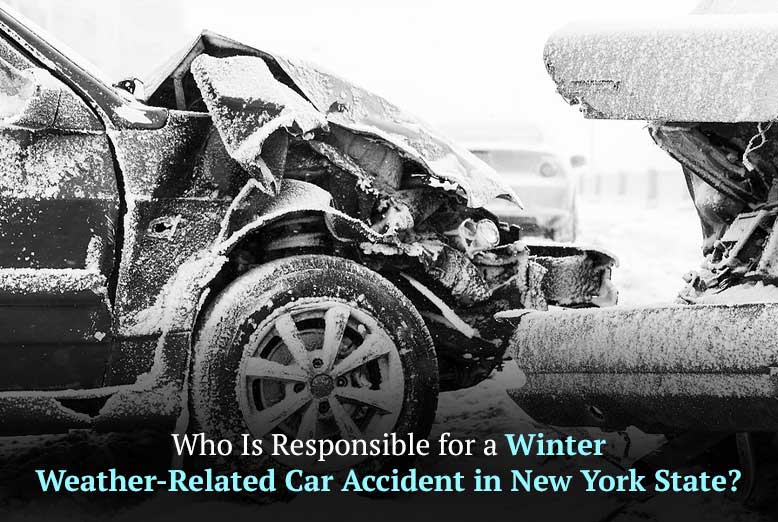Winter in New York State can be tough for drivers. Icy roads, heavy snow, and poor visibility can make driving dangerous and lead to accidents. Determining responsibility for a winter weather-related car accident can be complicated. Things like how someone drives, the condition of the roads, or mistakes by others can often be involved. While winter conditions may contribute to an accident, they rarely absolve drivers of their duty to operate vehicles safely. Understanding liability in these situations is essential for anyone involved in a winter weather crash.
Driver Negligence
Drivers are typically the first parties evaluated for liability in a winter car accident. They should be extra careful to stay safe, especially when the weather is bad. If a driver fails to adjust their speed, use headlights, or maintain a safe following distance, they could be deemed negligent. For instance, a driver speeding on an icy road might lose control and collide with another vehicle. In such cases, their failure to drive cautiously in poor conditions makes them liable. Insurance companies and courts assess whether a reasonable person would have acted differently under similar circumstances.
Road Maintenance Responsibility
Keeping roads in good condition plays a significant role in preventing accidents during winter. Government entities or private property owners responsible for maintaining roads, parking lots, or driveways must ensure these areas are safe for use. This includes clearing snow, salting icy patches, and addressing hazards promptly. If a government agency neglects its duty to maintain a public road, it could share liability for an accident. For example, if untreated black ice on a highway leads to a crash, the responsible agency might be held accountable. However, proving negligence in road maintenance cases often requires demonstrating that the hazard was known or should have been known and that the agency failed to act within a reasonable time.
Third-Party Negligence
Sometimes, third parties may contribute to a winter weather-related accident. This could include a commercial trucking company that fails to properly maintain its fleet, resulting in brake failure on icy roads. Another example is a construction crew that leaves debris on the roadway, making it hazardous during snowy conditions. Identifying third-party negligence requires a thorough investigation into the accident’s circumstances. Evidence such as maintenance records, surveillance footage, or witness statements can help establish liability.
Vehicle Maintenance Issues
Vehicle maintenance is another factor in determining responsibility for winter accidents. Drivers should make sure their cars are ready for winter weather. This includes maintaining proper tire tread, ensuring windshield wipers work effectively, and keeping brakes in good condition. A driver who neglects these responsibilities may be held partially or fully liable if their vehicle’s poor condition contributes to a crash. For example, a driver with bald tires sliding into another car on a snowy road may face consequences for their failure to prepare adequately for winter driving.
Comparative Negligence in New York
New York follows a comparative negligence rule, which means liability can be shared among multiple parties. Even if one driver is primarily at fault, others involved in the accident may bear some responsibility if their actions contributed to the collision. For instance, if one driver loses control due to speeding but another driver fails to yield, both may share liability. Under comparative negligence, compensation is reduced based on each party’s percentage of fault. This system ensures a fair allocation of responsibility and reflects the complexity of winter weather accidents.
Insurance Coverage Considerations
Insurance plays a significant role in addressing the financial consequences of winter car accidents. New York is a no-fault insurance state, meaning drivers typically turn to their own insurance policies for coverage of medical expenses and lost wages, regardless of fault. However, when serious injuries occur, victims may file a claim against the at-fault driver for additional compensation. Knowing what your insurance covers is essential to prepare you for something unexpected. Winter accidents can result in significant property damage and injuries, making adequate coverage essential.
Winter weather-related car accidents in New York State require careful examination of multiple factors to determine responsibility. While icy roads and snowstorms create hazards, drivers still have a duty to operate their vehicles safely. Road maintenance, third-party negligence, and vehicle preparation can also play key roles in causing or preventing accidents. Understanding how comparative negligence and insurance laws apply helps ensure that victims receive fair compensation. Those involved in these accidents should document the scene, seek medical attention, and consult with experienced legal professionals to protect their rights. Addressing liability fairly promotes accountability and encourages safer practices during New York’s harsh winter months.
Also Read: Approaching USAA for a Car Accident Claim? This Article is For You




















